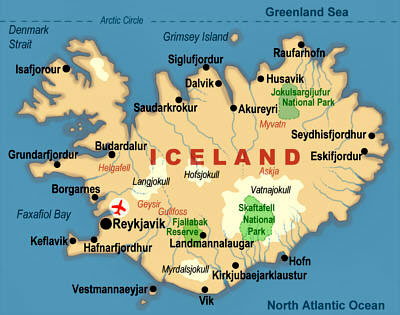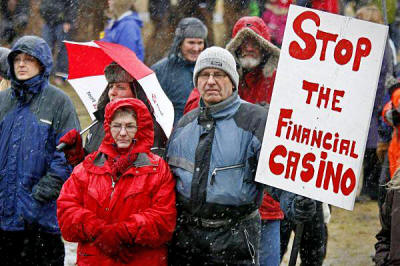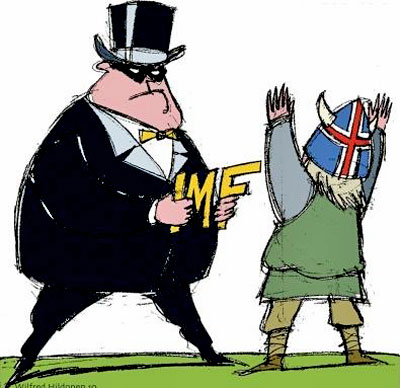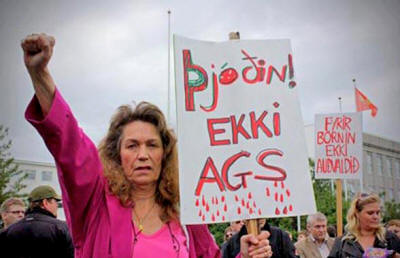"After more than 600 years of foreign rule,
Iceland's social structure was the most feudal of all Nordic countries
at the beginning of the 20th century.
Fishing dominated the economy, generating
most of the foreign-currency earnings and allowing the development of an
import-based commercial sector. This created urban economic activities:
construction, services, light industry.
After the second world war the economy grew
strongly, because of,
-
Marshall Plan aid (there was a large US-NATO
military base)
-
an abundant export commodity, cold-water fish, unusually
blessed with high income elasticity of demand
-
a small, literate population with a
strong sense of national identity
"As Iceland became more prosperous it established a welfare state, in
line with the tax-financed Scandinavian model, and by the 1980s had
attained a level and a distribution of disposable income equal to the
Nordic average.
Yet it remained both more regulated and more
patron-client-dominated than its European neighbors; a local oligopoly
restricted the political and economic landscape.
"There is a direct line of descent from the
quasi-feudal power structures of the 19th century to the modernized
Icelandic capitalism of the later 20th century, when a bloc of 14
families, popularly known as
The Octopus, were the economic and
political ruling elite.
The Octopus controlled imports, transport,
banking, insurance, fishing and supplies to the NATO base and provided
most top politicians. The families lived like chieftains.
"The Octopus controlled the rightwing Independence Party (IP) which
dominated the media and decided on senior appointments in the civil
service, police and judiciary.
The local, state-owned banks were
effectively run by the dominant parties, the IP and the Centre Party or
CP. Ordinary people had to go through party functionaries to get loans
to buy a car, or for foreign exchange for travel abroad.
Power networks operated as webs of bullying,
sycophancy and distrust, permeated with a macho culture, something like
the former Soviet Union.
"This traditional order was challenged from within by a neoliberal
faction, the Locomotive group, which had coalesced in the early 1970s
after law and business administration students at the University of
Iceland took over a journal, The Locomotive, and promoted free-market
ideas.
Their aim was not just to transform the
society but also to open career opportunities for themselves, rather
than wait for Octopus patronage.
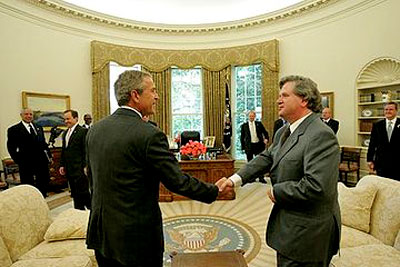
David Oddsson
At the end of the cold war their position
strengthened materially and ideologically, as the communists and social
democrats lost public support. The future IP prime minister,
David Oddsson, was a prominent member.
"Oddsson, born in 1948 with a middle-class background, was elected as an
IP councilor to the Reykjavik municipal council in 1974; by 1982 he was
mayor of Reykjavik, leading privatization campaigns, including selling
off the municipality's fishing industry, to the benefit of members of
the Locomotive group.
In 1991 he led the IP to victory in the
general election, and reigned (not too strong a word) as prime minister
for 14 years, overseeing the growth of the financial sector, before
installing himself as governor of the Central Bank in 2004. He had
little experience or interest in the world beyond Iceland.
His
Locomotive group protégé Geir Haarde, finance minister from 1998 to
2005, took over as prime minister shortly after.
These two men most directly steered
Iceland's great experiment to create an international financial centre
in the North Atlantic, midway between Europe and America.
"The liberalization of the economy began in 1994, when accession to the
European Economic Area, the free-trade bloc of EU countries, plus
Iceland, Lichtenstein and Norway, lifted restrictions on cross-border
flows of capital, goods, services and people. The Oddsson government
then sold off state-owned assets and deregulated labour.
Privatization began in 1998, implemented by
Oddsson and Halldor Asgrimsson, the leader of the CP.
Of the banks, Landsbanki was allocated to IP
grandees, Kaupthing to their counterparts in the CP, its coalition
partner; foreign bidders were excluded.
Later, Glitnir, a private bank
formed from the merger of several smaller ones, joined the league.
"So Iceland roared into international finance aided globally by abundant
cheap credit and free capital mobility, and domestically by strong
political backing for the banks. The new banks merged investment banking
with commercial banking, so that both shared government guarantees. And
the country had low sovereign debt, which gave the banks high marks from
the international credit-rating agencies.
The major shareholders of
Landsbanki,
Kaupthing,
Glitnir and their spin-offs reversed the earlier political
dominance of finance: government policy was now subordinated to the ends
of finance.
"Oddsson and friends relaxed the state-provided mortgage rules, allowing
90% loans. The newly privatized banks rushed to offer even more generous
terms. Income tax and VAT rates were lowered to turn Iceland into a
low-tax international financial centre. Bubble dynamics took hold.
City planners aimed to move Reykjavik from
the trajectory of an ordinary city to that of a world city (despite its
small population of 110,000) and approved several grandiose new public
and private buildings, saying,
"If Dubai, why not Reykjavik?"
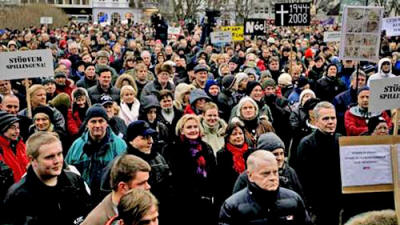
"Iceland's new banking elite were intent on expanding their ownership of
the economy, competing and cooperating with each other.
Using their
shares as collateral, some took out large loans from their own banks,
and bought more shares in the same banks, inflating share prices.
It worked like this:
Bank A lent to shareholders in Bank B,
who bought more shares in B using shares as collateral, raising B's
share price. Bank B returned the favor. The share prices of both
banks rose, without new money coming in. The banks not only grew
bigger, they grew more and more interconnected.
Several dealings of this kind are now under
criminal investigation by the special prosecutor, as cases of market
manipulation.
"Tiny Iceland soon managed to enter the big-bank league, with three
banks in the world's biggest 300 by 2006. The super-abundance of credit
allowed people to consume in extravagant celebration of their escape
from the earlier decades of credit rationing (on top of the earlier
escape from foreign rule as recently as 1944).
They saw themselves as fully independent at
last, which may explain their happiness ranking.
The owners and managers remunerated
themselves on an ever-larger scale. The richer they were, the more they
attracted political support. Their private jets, roaring in and out of
Reykjavik's airport, seemed to be visual and auditory proof to the
part-admiring, part-envious population below. Income and wealth
inequality surged, helped by government policies that shifted the tax
burden to the poorer population.
The bankers made large financial
contributions to the governing parties and giant loans to key
politicians.
The leading Icelandic champion of
free-market economics declared in The Wall Street Journal:
"Oddsson's experiment with liberal
policies is the greatest success story in the world."
"In the euphoria, the dangers of a strategy
of "economic growth based on vast foreign borrowing" were overlooked.
Icelanders lived out the dictum of Plautus, the third century BC Roman
playwright, who had one of his characters declare:
'I am a rich man, as
long as I do not repay my creditors.'
"In 2006 there were worries in the financial press about the stability
of the big banks, which were beginning to have problems raising funds in
the money markets (on which their business model depended).
Iceland's
current account deficit had soared from 5% of GDP in 2003 to 20% in
2006, one of the highest in the world. The stock market multiplied
itself nine times over between 2001 and 2007.
"Landsbanki, Kaupthing and Glitnir were operating far beyond the
capacity of Iceland's Central Bank to support them as lender of last
resort; their liabilities were real, but many of their assets were
dubious.
In February 2006 Fitch downgraded Iceland's
outlook from stable to negative and triggered the 2006 'mini-crisis':
-
the krona fell sharply
-
the value of banks' liabilities in foreign
currencies rose
-
the stock market fell and business defaults rose
-
the sustainability of foreign-currency debts became a public problem
The Danske Bank of Copenhagen described Iceland as a "geyser economy" on
the point of exploding.
"The lesson here is instructive across
the pond, but it is a chilling one. If the U.S. - or any sovereign
for that matter - attempts to restructure their debts, or to force
private investors to take a haircut on their own foolish gambles,
these international institutions have promised the equivalent of
economic war in response.
However, the alternative is for
representative governments to sacrifice their independence to a
cadre of faceless bankers who share no allegiance to any nation.
"It is the conflict that has already defined the beginning of the
21st Century. The question is whether free peoples will choose to
remain free, as Iceland has, or to submit."
Source
"Icelandic bankers and politicians brushed
aside the crisis.
Iceland's Central Bank took out a loan to double the
foreign-exchange reserves, while the Chamber of Commerce, run by
representatives of Landsbanki, Kaupthing, Glitnir and their spin-offs,
responded with a PR campaign.
It paid the American monetary economist
Frederic Mishkin $135,000 to lend his name to a report attesting to the
stability of Iceland's banks. It allegedly paid the London Business
School economist Richard Portes £58,000 ($95,000) to do the same for a
later report.
The supply-side economist Arthur Laffer
assured the Icelandic business community in 2007 that fast economic
growth with a large trade deficit and ballooning foreign debt were signs
of success:
'Iceland should be a model to the world.'
The value of the
banks' 'assets' was then around eight times greater than Iceland's GDP.
"In the elections of May 2007, the Social Democratic Alliance (SDA)
entered a coalition government with the still-dominant IP. To the
consternation of many supporters, SDA leaders ditched their pre-election
pledges and endorsed the continued expansion of the financial sector.
"Though they had survived 2006, Landsbanki, Kaupthing and Glitnir had
trouble raising money to fund their asset purchases and repay existing
debts, largely denominated in foreign currencies. So Landsbanki
pioneered
Icesave, an internet-based service that aimed to win retail
savings deposits by offering more attractive interest rates than
high-street banks.
Established in Britain in October 2006, and
in the Netherlands 18 months later, Icesave caught the attention of best
buy internet finance sites and was soon flooded with deposits. Millions
of pounds arrived from Cambridge University, the London Metropolitan
Police Authority, even the UK Audit Commission, responsible for
overseeing local government funds, as well as 300,000 Icesave depositors
in the UK alone.
"Icesave entities were legally established as branches, rather than
subsidiaries, so they were under the supervision of the Icelandic
authorities, rather than their hosts.
No one noticed that the Icelandic regulatory
agency had a total staff, including receptionist, of only 45 and
suffered high turnover as many went on to join the banks, which offered
better pay. No one worried much that, because of Iceland's obligations
as a member of the EEA deposit insurance scheme, its population of
320,000 would be responsible for compensating the depositors abroad in
the event of failure.
Landsbanki's shareholders reaped the
short-term profits while most Icelanders didn't know anything about
Icesave at all.
"The second 'solution' to difficulties in raising new funds was a way to
get more access to liquidity without pledging real assets as collateral.
The Big Three sold debt securities to a smaller regional bank, which
took these bonds to the Central Bank and borrowed against them, without
having to supply further collateral; they then lent back to the
initiating big bank. The bonds were called 'love letters' - mere
promises.
By participating in this game and accepting
as collateral claims on other Icelandic banks the central bank was
conniving in the banks' strategy of gambling for resurrection.
"Then the banks internationalized the process:
the Big Three established
subsidiaries in Luxembourg and sold love letters to them. The
subsidiaries sold them on to the Central Bank of Luxembourg or the
European Central Bank and received cash in return, which they could pass
back to the parent bank in Iceland or use themselves.
The OECD calculates that just the domestic
love letters, between the CBI and the Icelandic banks, incurred losses
to the CBI and the Treasury of 13% of GDP (OECD Economic Surveys:
Iceland, June 2011).
"The Icelandic banks fell two weeks after Lehman Brothers.
On 29
September 2008,
Glitnir approached Oddsson at the Central Bank for help
with its looming liquidity problem. To restore confidence, Oddsson
instructed the Central Bank to buy 75% of Glitnir's shares. The effect
was not to boost Glitnir but to undermine confidence in Iceland.
The country's rating plunged, and credit
lines were withdrawn from Landsbanki and Kaupthing. A run on Icesave's
overseas branches began. Oddsson moved on 7 October 2008 to peg the
krona to a basket of currencies at close to the pre-crisis value.
With the currency tumbling and in the
absence of capital controls, the foreign-exchange reserves were
exhausted: the peg lasted for only a few hours, just long enough for
those in the know to change their money out of the krona at a much more
favorable rate. Inside sources indicate that billions left the currency
in these hours.
Then the krona was floated, and sank. On 8
October the then UK prime minister, Gordon Brown, froze Landsbanki's UK
assets under the anti-terrorism laws.
The stock market, bank bonds, house prices
and average income went into free-fall.
"The IMF arrived in Reykjavik in October 2008 to prepare a
crisis-management program, the first time the Fund had been called in to
rescue a developed economy since Britain in 1976.
It offered a
conditional loan of $2.1bn to stabilize the krona and backed the British
and Dutch governments' demands that Iceland should honor the obligations
of the European deposit-guarantee scheme and recompense them for their
bailouts of Icesave depositors.
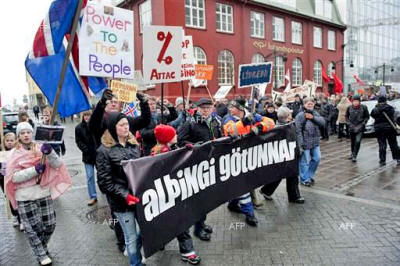
"Iceland's normally placid population erupted in an angry protest
movement, principally targeted at Haarde, Oddsson and the IP, although
the SDA's foreign minister Ingibjorg Gisladottir was considered
tarnished too.
Thousands of people assembled in Reykjavik's
main square on freezing Saturday afternoons between October 2008 and
January 2009, banged saucepans, linked arms in a circle around the
parliament building to demand the government's resignation, and pelted
the building with food.
"In January 2009, the IP-SDA coalition broke.
To date, Iceland is the
only country to have shifted distinctly to the left after the financial
crisis. An interim SDA-LGM (Social Democrats-Left Green Movement)
government was formed in January 2009 to lead until April's election. In
the election the IP was reduced to 16 seats, despite the overwhelming
bias of the electoral system in its favor, its worst result since its
formation in 1929.
"The SDA-LGM government came under immediate pressure to repay the
Icesave debt; much of the IMF loan was withheld until Reykjavik agreed.
The new government was also divided on
whether to apply for full membership of the EU and Eurozone, with most
of the SDA strongly in favor. After long negotiations, the government
presented the terms they had agreed on the Icesave debt to the
parliament in October 2009:
£5.5bn ($7.8bn), or 50% of Iceland's GDP,
was to be paid to the British and Dutch treasuries between 2016 and
2023.
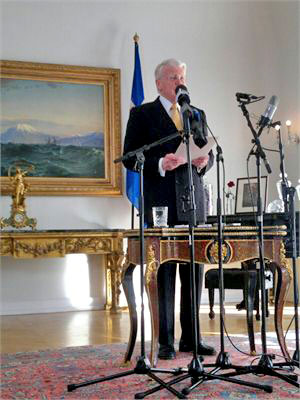
Halldor Asgrimsson
"The party's health minister resigned in protest, five dissidents
refused to vote with the government. The bill was forced through on 30
December 2009, against high feelings in the country.
On 5 January 2010 President Grimsson
announced that he would not sign it into law, out of respect for the
national sentiment. In the ensuing referendum the bill was decisively
rejected. In the May 2010 Reykjavik municipal elections, the SDA slumped
to 19% and a comedian was elected as the city's mayor.
In October protests resumed, and the
coalition conceded the election of a constitutional assembly to draw up
a new constitution (the existing one having been inherited from Denmark
on independence in 1944). When the election was invalidated by the
Supreme Court, the assembly was reconvened as a constitutional council
appointed by parliament.
"The deal on the table in this April's second Icesave referendum
involved substantial concessions on the part of the British and Dutch
governments. After the no vote, the disagreement may have to go to
international courts.
"The cost of losses on loans and guarantees, added to the cost of
restructuring financial organizations, brings the total direct fiscal
costs of the crisis to about 20% of GDP, higher than in any other
country except Ireland (OECD Economic Surveys, Iceland, June 2011).
But the postponement of major public
spending cuts until this year [2011] has given the economy breathing
space; and the sharp devaluation has helped to generate a trade surplus
for the first time in many years. So far, Iceland has experienced
smaller falls in GDP and employment than big public-spending slashers
like Ireland, Estonia and Lithuania.
The unemployment rate, only 2% in 2006, has
been between 7% and 9% since 2009; but the rate of outmigration, of
Icelanders and other European workers (predominantly Polish), has been
the highest since 1889.
However, the SDA-LGM government has announced
drastic cuts in public spending for 2011 and beyond. Local governments
have no budget for fresh projects. Hospitals and schools are cutting
salaries and sacking employees.
The freeze on house repossessions expired in
2010.
"The IP-SDA government's decision to provide unlimited bank deposit
guarantees illustrates its debt to the financial elite.
Had it limited the guarantee to 5m krona
($70,000), it would have protected the entire deposits of 95% of
depositors; only the wealthiest 5%, including many politicians,
benefited from the unlimited guarantee, which now means further
constraints on public spending.
"Iceland's tiny scale seemed to make it easier to challenge the
government's denial of the impending crisis, but the opposite was true.
The Oddsson government undertook an extreme privatization of
information. Iceland's National Economic Institute had a reputation for
independent thinking, and Oddsson abolished it in 2002.
From then on the banks, international rating
companies and the Chamber of Commerce provided almost the only
information and running commentary on the state of the economy, present
and future.
"Paradoxically, a number of critical reports were published when the
bubble was in the early stages, including one by the CBI.
But by 2007-08, when the dangers were acute,
reports, including those by the IMF, became noticeably softer in tone.
It seems that the official financial institutions, as well as bankers
and politicians, understood that the situation was so fragile that just
to speak of it might trigger a run on the banks.
"In October 2010 the parliament decided to charge Prime Minister Haarde
for breach of ministerial responsibility. The permanent finance
secretary Baldur Gudlaugsson (former member of the Locomotive group) has
been given two years in prison for using inside information for his
personal advantage while selling his shares in Landsbanki in September
2008.
But the special prosecutor in charge of the
investigation of the banks has been working with a team of 60 lawyers
and others for the past two years and has so far brought no charges.
Meanwhile Oddsson was appointed in September 2009 as editor-in-chief at
Morgunbladid, the leading Iceland daily, and orchestrated coverage of
the crisis.
A commentator said that was like,
"appointing
Nixon editor of The Washington Post after Watergate. Iceland's elite
looks after its own." 1

